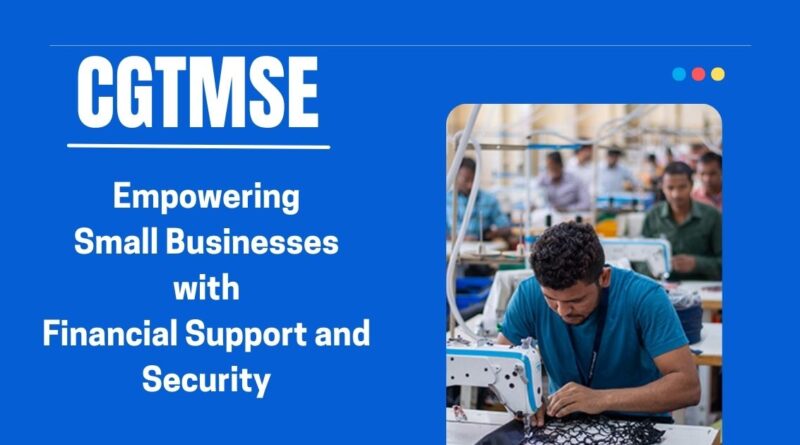CGTMSE: Empowering Small Businesses with Financial Support and Security
Are you a micro or small enterprise owner looking for financial assistance to grow your business? The Credit Guarantee Fund Trust for Micro and Small Enterprises (CGTMSE) could be just what you need. In this article, we’ll explain everything you need to know about CGTMSE and how it can benefit your business.
Table of Contents
What is CGTMSE?
The Credit Guarantee Fund Trust for Micro and Small Enterprises (CGTMSE) is a trust launched by the Government of India to help micro and small enterprises (MSEs) access credit facilities without having to provide collateral. The scheme was launched in August 2000 and is managed by the Small Industries Development Bank of India (SIDBI) in collaboration with the Ministry of Micro, Small, and Medium Enterprises (MSMEs).
How does it work?
CGTMSE provides a credit guarantee cover for loans up to Rs. 2 crores extended to MSEs by eligible lending institutions. The guarantee cover provided is up to 75% of the credit facility, subject to a maximum of Rs. 1.5 crores. This means that if an MSE defaults on a loan, CGTMSE will reimburse the lending institution up to 75% of the outstanding loan amount, subject to the maximum limit.
Who is eligible for CGTMSE?
All micro and small enterprises are eligible for CGTMSE, subject to certain conditions. The enterprises should be engaged in manufacturing or service activities and have a maximum investment of up to Rs. 50 lakhs in plant and machinery for manufacturing enterprises and up to Rs. 10 lakhs in equipment for service enterprises.
In which lending institutions this scheme is available?
CGTMSE covers lending institutions that are eligible to provide credit to MSEs, including scheduled commercial banks, regional rural banks, select state cooperative banks, and select non-banking financial companies (NBFCs). The lending institutions have to pay a one-time guarantee fee and an annual service fee to avail of the CGTMSE facility.
What are the benefits of CGTMSE-Coverage?
- CGTMSE provides numerous benefits to MSEs, including No collateral required: The biggest advantage of is that MSEs do not need to provide collateral to avail of credit facilities.
- Access to credit: It guarantees up to 75% of the credit facility, making it easier for MSEs to access credit and grow their businesses.
- Lower interest rates: Since it provides a credit guarantee cover, lending institutions are more willing to provide credit at lower interest rates to MSEs.
- Simplified procedures: The procedures for availing of cover is simplified, making it easier for MSEs to apply for credit facilities.
- Reduced risk: It reduces the risk of default for lending institutions, making them more willing to provide credit to MSEs.
Why CGTMSE is important for businesses?
- The CGTMSE scheme is available to both new and existing micro and small enterprises.
- The scheme covers term loans, working capital loans, and composite credit facilities, which include both term loans and working capital components.
- The guarantee cover is available for a period of up to 5 years or the repayment period of the credit facility, whichever is earlier.
- Guarantee cover provided is available for both primary and collateral security-free loans, subject to certain conditions.
- The lending institutions have to comply with certain norms and procedures to avail of this facility, including due diligence, appraisal, and monitoring of the credit facilities.
- The lending institutions are required to maintain a minimum portfolio guarantee cover of 75% of the outstanding credit facility amount.
- The CGTMSE scheme is part of the larger MSME ecosystem in India, which includes various other schemes and initiatives by the government to support the growth and development of the sector.
How much fee is required to cover loans under CGTMSE?
- MSEs that have availed of credit facilities under CGTMSE are required to pay a guarantee fee, which is a one-time fee charged at the time of availing the credit facility. The guarantee fee ranges from 0.75% to 1.5% of the credit facility amount, depending on the category of the enterprise and the credit facility availed.
- MSEs that have availed of credit facilities under CGTMSE are also required to pay an annual service fee, which is charged every year until the credit facility is repaid in full. The annual service fee ranges from 0.50% to 0.75% of the outstanding credit facility amount, depending on the category of the enterprise and the credit facility availed.
- The CGTMSE scheme has undergone several revisions over the years to make it more inclusive and accessible to a larger number of MSEs. In 2016, the scheme was modified to increase the maximum credit facility limit from Rs. 1 crore to Rs. 2 crores and to extend the guarantee cover to loans provided to MSEs under the Mudra scheme.
- The CGTMSE scheme has been instrumental in enabling MSEs to access credit facilities and grow their businesses. According to the CGTMSE website, as of March 2021, the scheme had facilitated the sanction of over 44 lakh credit facilities and had provided a guarantee cover of over Rs. 2.56 lakh crores.
- The CGTMSE scheme has also been recognized as an effective tool for financial inclusion and poverty alleviation. It has enabled MSEs from diverse sectors and regions to access credit facilities and has helped create jobs and promote economic growth in rural and semi-urban areas.
How it works after the loan account gets NPA? Explained.
When a loan account gets classified as Non-Performing Asset (NPA), it means that the borrower has defaulted on repayment of the loan, and the lender is unable to recover the outstanding amount despite following the due process. In such cases, the CGTMSE scheme provides a guarantee cover to the lending institution for a portion of the outstanding amount, subject to certain conditions.
After a loan account gets classified as NPA, the lending institution has to invoke the guarantee cover provided by CGTMSE within 90 days from the date of the account turning NPA. The lending institution has to submit a claim application to CGTMSE along with the necessary documents and information, including details of the credit facility availed by the borrower, the amount outstanding as on the date of NPA classification, and the amount recovered from the borrower or other sources.
CGTMSE verifies the claim application and the supporting documents and approves the claim within 30 days of receipt of the complete claim application. Once the claim is approved, CGTMSE pays the guarantee cover amount to the lending institution, which reduces the outstanding amount on the credit facility. The lending institution can then initiate recovery proceedings to recover the remaining outstanding amount.
It is important to note that the guarantee cover provided by CGTMSE is subject to certain conditions and limitations. The maximum guarantee cover available under the scheme is 75% of the credit facility amount or Rs. 1.5 crores, whichever is lower. The guarantee cover is available only for the portion of the credit facility that is backed by CGTMSE and not for any collateral security provided by the borrower. The lending institution is required to follow the due process of recovery and obtain necessary approvals before invoking the guarantee cover.
Which is better CGTMSE or Property as Security to loan?
The decision to opt for CGTMSE or Property as Security to avail a loan depends on various factors, including the borrower’s credit profile, business requirements, and the lending institution’s policies.
CGTMSE is a government-backed scheme that provides a guarantee cover to the lending institution for a portion of the outstanding amount in case of default by the borrower. The scheme enables MSEs to access credit facilities without providing any collateral security or third-party guarantee. This makes the scheme particularly beneficial for small and micro-enterprises that may not have adequate collateral security to offer.
On the other hand, providing property as security to avail a loan is a common practice in the lending industry. The lender can use the property as collateral to recover the outstanding amount in case of default by the borrower. This reduces the lender’s risk and may result in lower interest rates and better loan terms for the borrower.
However, offering property as collateral has its own risks. In case of default, the lender can take possession of the property and sell it to recover the outstanding amount. This can lead to financial loss and can impact the borrower’s credit profile.
Advantages and Disadvantages of CGTMSE

CGTMSE (Credit Guarantee Fund Trust for Micro and Small Enterprises) is a government-backed scheme that aims to provide collateral-free credit facilities to Micro and Small Enterprises (MSEs) in India. Like any other scheme or policy, CGTMSE has its own advantages and disadvantages. Here are some of them:
Advantages of CGTMSE:
Easy Access to Credit: One of the main advantages is that it enables MSEs to access credit facilities without providing any collateral security or third-party guarantee. This makes it easier for MSEs to obtain credit facilities and expand their business operations.
Lower Interest Rates: Since the guarantee cover reduces the lending institution’s risk, it may result in lower interest rates and better loan terms for the borrower.
Government-Backed: This scheme is backed by the government of India, which instills confidence in the lending institution and the borrower. This can help in attracting more lenders to participate in the scheme and increase its reach.
Covers a Wide Range of Credit Facilities: The scheme covers a wide range of credit facilities, including term loans, working capital loans, and letter of credit/bank guarantee facilities. This provides MSEs with access to different types of credit facilities to meet their specific business requirements.
Disadvantages of CGTMSE:
Limited Guarantee Cover: The maximum guarantee cover available under the scheme is 75% of the credit facility amount or Rs. 1.5 crores, whichever is lower. This may not be sufficient for larger MSEs with higher credit requirements.
Certain Conditions and Limitations: The guarantee cover provided by this scheme is subject to certain conditions and limitations, including the due process of recovery and obtaining necessary approvals before invoking the guarantee cover. This can lead to delays in obtaining the guarantee cover and recovering the outstanding amount.
Eligibility Criteria: This scheme is available only to Micro and Small Enterprises, which may exclude larger enterprises from availing the benefits of the scheme. Additional Charges: The lending institution may charge additional fees and charges for availing the guarantee cover provided by CGTMSE, which may increase the overall cost of the credit facility.
How to apply for CGTMSE Coverage?
Borrowers need not apply specifically by themself but they give in writing to the bank to cover their loan under this scheme. Bank will cover your loan under this scheme by filling online form on the CGTMSE website. After verification, CGTMSE will ask to pay fees against the coverage, and the bank debit the amount to the borrower’s account and remit it to CGTMSE. The bank generates acknowledgment of payment from a website and keeps it for records.
Conclusion
In conclusion, The Credit Guarantee Fund Trust for Micro and Small Enterprises is a beneficial scheme for Micro and Small Enterprises that enables them to access credit facilities without providing any collateral security or third-party guarantee. However, it is important for MSEs to evaluate the scheme’s various features, conditions, and limitations before opting for it.
CGTMSE is an excellent initiative by the Government of India to support micro and small enterprises in the country. It provides a credit guarantee cover to MSEs, making it easier for them to access credit and grow their businesses. If you’re an MSE owner, we highly recommend exploring the CGTMSE scheme and taking advantage of its benefits.
This CGTMSE scheme is crucial for MSEs in India, providing them with access to credit facilities and enabling them to grow their businesses. It is important for MSE owners to be aware of the scheme’s various features and benefits, and to work with eligible lending institutions to avail of credit facilities under the scheme.
The CGTMSE scheme provides a guarantee cover to the lending institution in case of default by the borrower, thereby enabling the lending institution to recover a portion of the outstanding amount. It is important for lending institutions and borrowers to be aware of the scheme’s various features and conditions and to follow the due process to avail of the benefits of the scheme.
Both CGTMSE and Property as Security have their own advantages and disadvantages, and the decision to opt for either depends on various factors. Borrowers should evaluate their options carefully and choose the option that best suits their business requirements and financial situation.
Frequently Asked Questions
What is CGTMSE?
CGTMSE stands for Credit Guarantee Fund Trust for Micro and Small Enterprises. It is a financial initiative introduced by the Government of India to provide collateral-free credit facilities to micro and small enterprises.
What is the objective of CGTMSE?
The main objective of the scheme is to facilitate easy access to credit for micro and small enterprises by providing a guarantee cover on the loans extended by banks and financial institutions.
Who is eligible for CGTMSE coverage?
Micro and small enterprises in the manufacturing and service sectors, including retail trade, are eligible for coverage. The eligibility criteria vary based on the investment in plant and machinery or equipment for manufacturing enterprises and the investment in equipment for service enterprises.
How does CGTMSE work?
Under CGTMSE, banks and financial institutions provide loans to eligible micro and small enterprises without the requirement of collateral or third-party guarantee. CGTMSE provides a guarantee cover of up to a certain percentage of the loan amount, thereby mitigating the risk for the lending institution.
What is the maximum loan amount covered under CGTMSE?
Earlier scheme provides a guarantee cover of up to Rs. 2 crore on the credit facilities extended to eligible micro and small enterprises but now it is extended up to Rs. 5 Crore.
What is the fee for availing of CGTMSE coverage?
The fee for availing coverage is charged by the lending institution and is based on the loan amount and the credit rating of the borrower. The fee is typically a one-time payment made at the time of availing the loan.
Is there any collateral requirement for loans covered under CGTMSE?
No, loans covered under CGTMSE do not require collateral or a third-party guarantee. The guarantee provided substitutes the need for collateral.
Can existing loans be covered under CGTMSE?
Yes, existing loans can be covered under CGTMSE, subject to certain conditions and guidelines provided by CGTMSE and the lending institution.
Are all banks and financial institutions covered under CGTMSE?
No, not all banks and financial institutions are covered under CGTMSE. Only those institutions that have entered into an agreement with CGTMSE and comply with its guidelines can provide loans covered under CGTMSE.
Can a borrower approach multiple banks for loans covered under CGTMSE?
No, a borrower can approach only one bank or financial institution for availing of a loan covered under CGTMSE. Multiple applications to different institutions for the same loan requirement are not allowed.




